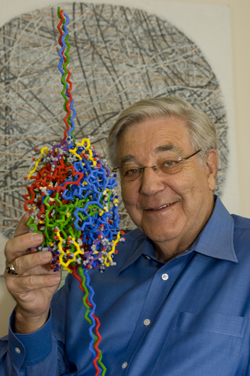
Billy Hudson, Ph.D., holds a model of the Collagen IV molecule, one of the areas being explored under a grant to study the kidney’s filtration mechanism. (photo by Dana Johnson)
Grant bolsters study of kidney’s filtration system
Researchers at Vanderbilt Medical Center have been awarded a Program Project Grant (PPG) to study the kidney's filtration mechanism.
The grant, funded by the National Institute of Diabetes and Digestive and Kidney Diseases, awards $6 million over five years.
“We're going on an expedition to explore the deepest mysteries of the kidney and how it filters,” said Billy Hudson, Ph.D., project leader and director of the Center for Matrix Biology.
The glomerulus is the filtration apparatus of the kidney that allows metabolic waste to be eliminated from the body.
Diseases of the glomerulus account for more than 60 percent of cases of end-stage renal disease, but little is known about the filtration mechanism.
Hudson's team has already discovered the major molecules of the kidney basement membranes, called collagen-IV networks, which play a key role in filtration.
The research will have four subprojects:
• Project 1, led by Hudson and Vadim Pedchenko, Ph.D., will explore the structure and assembly of collagen-IV networks.
• Project 2, led by Ambra Pozzi, Ph.D., Brandt Eichman, Ph.D., and Sam Santoro, M.D., will study how the networks interact with integrins (cell surface receptors).
• Project 3, led by Roy Zent, M.D., Ph.D., and Chuck Sanders, Ph.D., will study how integrins affect cell behavior.
• Project 4, led by Dale Abrahamson, Ph.D., from Kansas University and Jeff Miner, Ph.D., from Washington University, will study how the cells and basement membrane work together to function as a filter.
The matrix biology core will be led by Roy Zent, M.D., Ph.D., Pedchenko, and Roberto Vanacore, Ph.D.
“Our goal is to gain novel insights that will serve as a platform for the development of drugs that protect against diseases like diabetic nephropathy, Goodpasture syndrome and Alport syndrome,” Hudson said.
For diabetes patients with kidney complications — 80 million people worldwide — the kidney filter is abnormal. The basement membrane is three-to-10 times normal size, and it allows proteins to escape from the body. Hudson hopes this research will explain why.
The PPG involves about 20 Vanderbilt scientists from several fields, including nephrology, biochemistry, cell biology, NMR spectroscopy, computational molecular modeling, integrin biology, X-ray crystallography and cryo-electron microscopy.
“It brings together scientists from the College of Arts and Sciences and the School of Medicine at Vanderbilt, and scientists from Kansas University Medical Center and Washington University,” Hudson said.
“It is the first example of members of the Center for Structural Biology being brought in for a Program Project Grant to explore a medical problem. It's a unique team that's never been put together before to explore the kidney, and we have the right people at the right time to work together to find these answers,” Hudson said.
“There's a collegiality and collaborative climate at Vanderbilt that is second to none.”
The PPG also has an external adviser panel of international experts who will review and advise on progress, including ones from Lilly Research Laboratories and the Karolinska Institute.
Hudson is Elliot V. Newman Professor Medicine, Biochemistry and Pathology.













